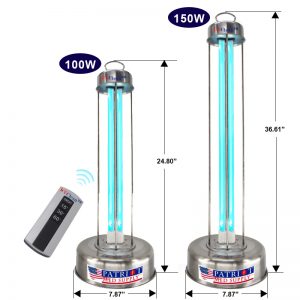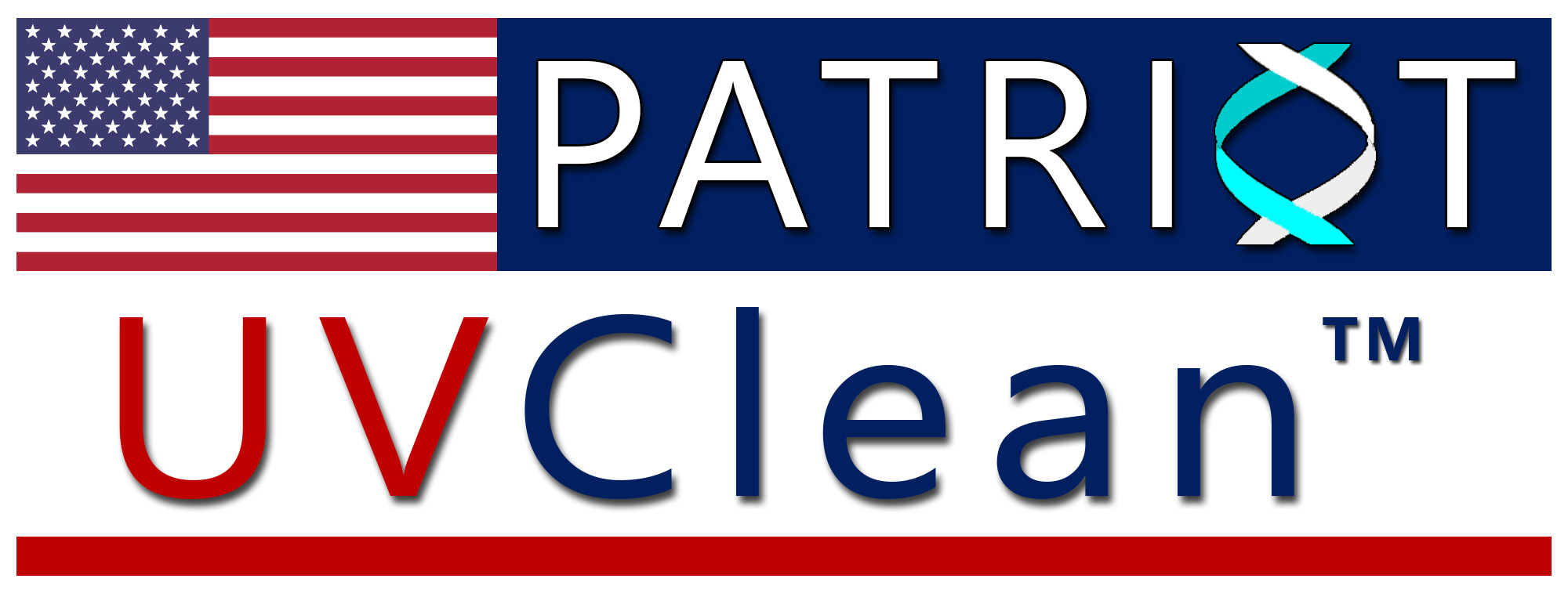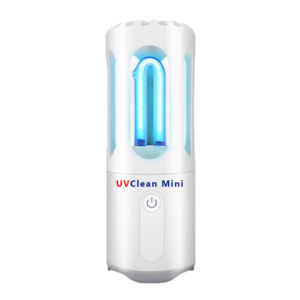About UVC
The following information is merely an introduction to Ultraviolet C. Many facts are adapted from the 2009 Ultraviolet Sanitizer Irradiation Handbook by Wladyslaw Kowalski. Additional citations for facts below are shown on the Efficacy Page of this website, along with further UVC scientific findings.
Ultraviolet C Light Spectrum
Ultraviolet light belongs in the non-visible electromagnetic spectrum with a wavelength in the range of 200 to 400 nm (nanometers), which is shorter than that of visible light, but longer than X-rays.
The UV-C wavelengths (also called sanitizer wavelength) are short-wave between 200 and 280 nm.
Patriot UVClean products emit a 253.7 nm which is an optimal wavelength for deactivating the DNA of microorganisms.
Patriot Engineering is also on the leading edge of ”Far-UVC” lamp development, which emits a 222 nm wavelength, a disinfecting light that can be safely operated with humans and animals present. More about Far-UVC here from Ted Talks: https://www.ted.com/talks/david_brenner_can_light_stop_the_coronavirus#t-276914
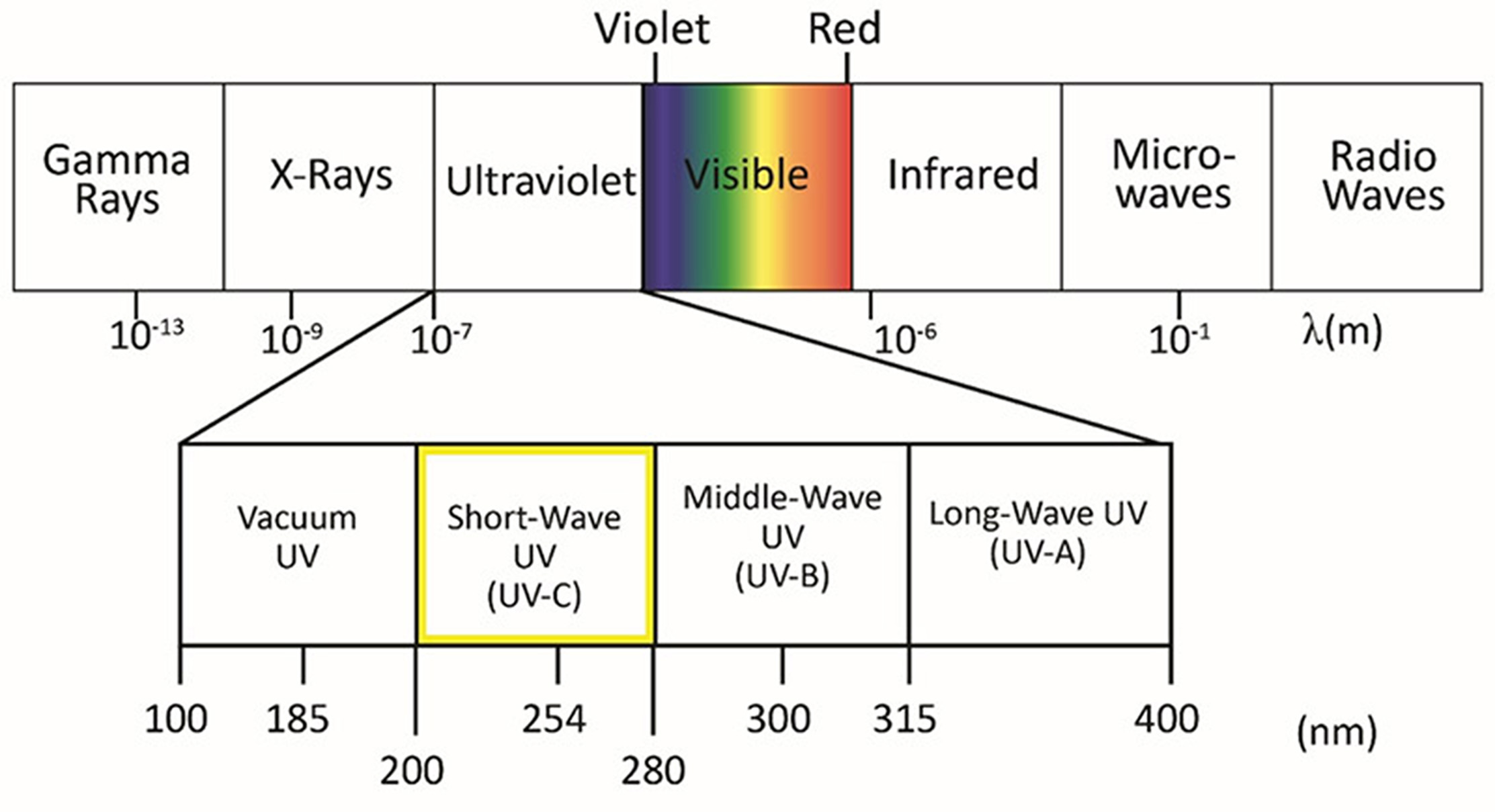
All the above wavelengths of UV light are emitted by the sun, but only the longer wavelengths, UV-A and UV-B reach the earth. The UV-C rays, which are the shortest wavelength but highest energy are blocked by the ozone layer.
UVC, UVGI, GUV, & Sanitizer Terms
Different terms are used to refer to the use of Ultraviolet radiant energy to inactivate bacteria, mold spores, fungi, or viruses. Accurate terminology includes
The term ‘UVC’ is the narrow-band’ range of UV wave-lengths between 200 and 280 nm. Most products currently sold for their sanitizer properties emit a 254 UV wavelength.
The term “UVGI” refers to “Ultraviolet Sanitizer Irradiation” as used by Federal Agencies such OSHA, NIOSH, GSA, EPA and the CDC when referring directly to UVC.
“Far-UVC” refers to UVGI lamps that emit an Ultraviolet wavelength of 222 nm, which can be used in environments where humans and animals are present.
Other terms include UVR (ultraviolet radiation) and GUV (sanitizer ultraviolet)
The term ‘sanitizer’ implies that these UV systems destroy, kill, or inactivate microorganisms such as viruses, bacteria, and fungi. Technically, viruses are molecules, and more accurate to refer to viruses as “inactivated” rather than “killed”. Sanitizer is better stated as disinfection, which describes the reduction to extinction of the microbial population, whether in air, water, or on surfaces.
UVC Historical Milestones
William F. Wells, a 1930’s Harvard University sanitary engineer, discovered that bacteria and viruses can be transmitted to people through the air they breathe. Wells executed several successful public applications of UVC to prove its effectiveness in killing airborne microorganisms.
The resurgence of tuberculosis (TB) during the 1980s drove renewed focus to UVC, which has continued to escalate with multi- and extensive drug-resistant TB, bioterrorism, influenza pandemics, SARs, MERs, and most recently needed solutions for COVID-19.
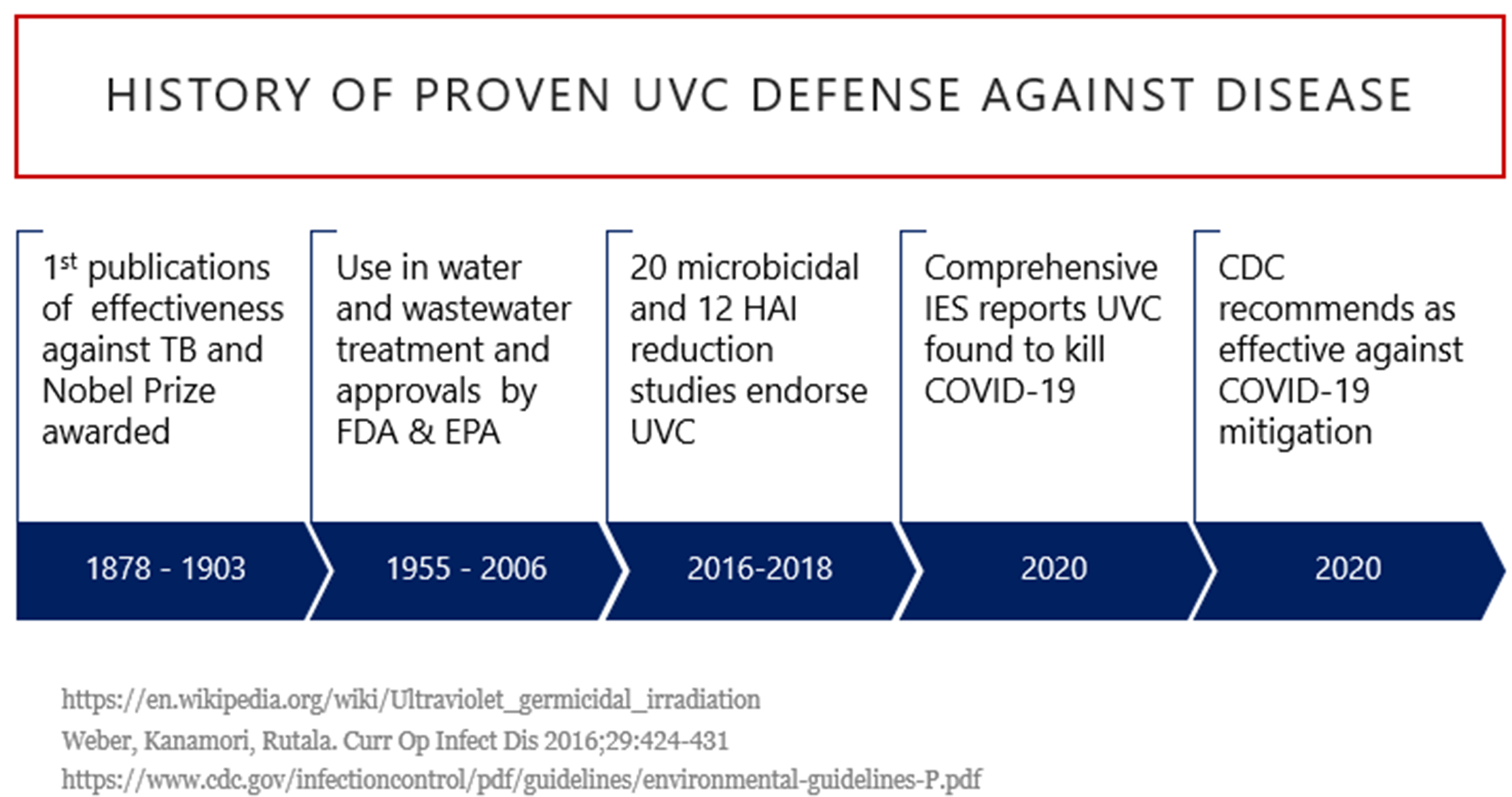
UVC Disinfectant Properties & Effectiveness
Since UVC rays are blocked by the ozone layer, microorganisms have not developed a natural defense against UVC energy. When the DNA of a microorganism absorbs UVC energy, molecular instability occurs, resulting in the disruption of the DNA sequence. This renders the cell unable to grow or reproduce. Without the ability to reproduce, the cell cannot grow on surfaces, cannot infect, and rapidly die.
Individual, energetic UVC photons photochemically interact with the RNA and DNA molecules in a virus or bacterium to render these microbes non-infectious.
Proven by studies and field testing, UVC effectively inactivates the SARS COV-2 which is responsible for COVID19, among other viruses and pathogens. (refer to Efficacy Page on this website for extensive scientific support for UVC)
The effectiveness of disinfection from in-room UVC equipment depends on ‘line-of-sight’ exposure of the microorganisms to the UV light. Environments where area design creates obstacles that block the UV light, effectiveness is then reliant on the placement of the UVC units so that line of sight is optimum for disinfection.
UVClean products are designed to address various room configurations and our knowledgeable Representatives work with customers to achieve top coverage.
Increases in effectiveness and UV intensity can be achieved by using reflection. Aluminum has the highest reflectivity rate versus other metals and is recommended when using UV.
Patriot UVClean patent-pending designs use the highest quality European-sourced Aluminum materials which amplify the reflectivity rate and effectiveness of UVC treatment to the target area.
Effectiveness of Low-Wattage and Portable Products
Hand-held, compact UVC products have been available for more than a decade and provide reliable disinfection of small objects and target surfaces. A portable wand of 4 watts emits a 4 mW·cm2 of 254-nm UVC at contact and should be held above the surface for several seconds for an effective multi-log unit disinfection. (i.e. skimming a wand across a cell phone, keyboard, or other object for one second will not provide adequate disinfection).
Patriot UVClean’s Product Portfolio includes 2 multi-purpose portables for its customers. These quality special-purpose products are effective for spot disinfecting, specific areas, and other use cases. Manuals are included to address each specific product to ensure proper use for optimal effectiveness.
Time and Intensity Dosage
UVC effectiveness for air and surface disinfection applications is estimated by calculating the UVC dose which will be delivered to the microbial population. The UV dose is calculated as follows:
UV dose (μW·s/cm2) = UV intensity (μW/cm2) × exposure time (seconds)
The dosage, a product of UVC light intensity and exposure time, is usually measured in microjoules per square centimeter. One joule is equal to one watt times one second. (1 W = 1 J/s) A millijoule is one-thousandth of a joule. Recommended exposures to disinfect surfaces vary from 200 to 1,000 J/m2 (20 to 100 mJ/cm2, pending on type of surface and its cleanliness.
The degree of inactivation of microorganisms by ultraviolet radiation is causally related to the UVC dose applied. For example, if a certain UV exposure kills 90% of a bacterial population (“one-log kill”), doubling the exposure time or intensity can kill only 90% of the residual 10%, for an overall sanitizer efficacy of 99% (“two-log kill”). Likewise, a 50% decrease in dose or exposure time decreases sanitizer efficacy only from 99% to 90%.
In practice, achieving two log-kills (99% inactivation) is frequently accepted
Dosages for a 90% kill of most bacteria and viruses range between 2,000–8,000 μW·s/cm2. Larger parasites such as cryptosporidium require a lower dose for inactivation. As a result, the U.S. Environmental Protection Agency has accepted UVC disinfection as a method for drinking water plants to obtain cryptosporidium, giardia, or virus inactivation credits.
Humidity can reduce the effectiveness of sanitizer UVC radiation and should be compensated in regard to time and intensity calculations.
UVC Efficacy Testing Criteria
Research scientists determine efficacy for deactivation of different microorganisms and viruses using the photobiology’s fundamental concept of action spectrum (or relative response) for a given effect. Action spectra for spores, E. colibacteria, bacteria, viruses, and other pathogens can vary. This standardized action spectrum extends from 235 nm to 313 nm and peaks at approximately 265 nm. A wavelength of 254 nm has a relative efficacy of 0.85.
Independent laboratory testing has validated color change associated with 2 log (99% inactivation) reduction for MRSA and C. difficile. In practice, achieving 2 log or 99% inactivation is typically accepted as the effective measurement of success.
UVClean provides 3rd party UVC-sensitive lab test patches for self-monitoring surface sanitation. The card’s testing patches are calibrated on independent lab validation of color change associated with Ultraviolet-C exposure and will turn from yellow to green as irradiation progresses. (learn more on the UVC Test Card Page of this website)
FAQs: Best Practices & Operations
Below list several FAQs regarding practical UVC use in action. (Learn more about best practices on the Safety Page on this website)
Q. Does use of UVC technology eliminate other methods of disinfecting and cleaning services?
A. No. The UVC appliance is an adjunct technology used in conjunction with cleaning in hospital ERs, operation theaters and IC units, in hotel rooms, restrooms, schools, and businesses, and other public spaces.
Q. Can the room be occupied immediately after a UV-C disinfection cycle?
A. Yes. It is safe to occupy and use the space immediately upon completion of UVC appliance’s treatment cycle.
Q. Does the UVC appliance produce chemicals or by-products?
A. No, UVC light is environmentally friendly. There are no chemicals or by-products from UVC disinfection.
Q. Will UVC degrade objects in the room?
A. UVC is a short wavelength light and does not penetrate most objects. Day to day operational disinfection in hospitals, schools, and businesses does not accumulate sufficient exposure time to cause any material degradation.
Q. What happens when someone walks in the room when the device is operating?
A. Large wattage Patriot UVClean devices have special heat-sensitive detection sensors, which deactivate the system if humans or animals enter the operational area.
Q. What regulatory entities oversee UVC?
A. Patriot UVClean appliances, like other UVC sanitizers are intended for environmental sanitation and therefore regulated by the Environmental Protection Agency (EPA). Although UVC irradiation devices are heavily used in medical environments to decontaminate air and surfaces, they are not for use on the human body or on animals, and therefore not regulated by FDA. (Some UVC technology, such as equipment used for irradiating foods or medical devices used on humans, is FDA regulated.)
Q. Are Patriot UVClean sanitizer appliances compliant?
A. Yes. Patriot UVClean devices are compliant with EPA guidelines, as well as other US and global regulatory bodies. All appliances have been 3rd-party tested by internationally recognized testing authority SGS. Certifications include EPA & FCC (USA); CE & LVD (EU); PS & ICC (Philippines); ISO 9000 & ISO 14000, UL.
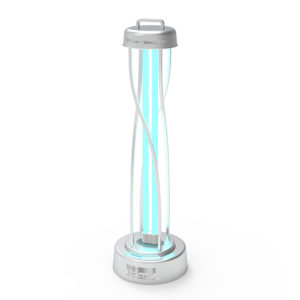
UVClean Sterilizer™ 120w
UVClean Mini Sterilizer™
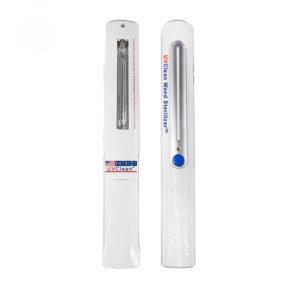
UVClean Wand Sterilizer™
